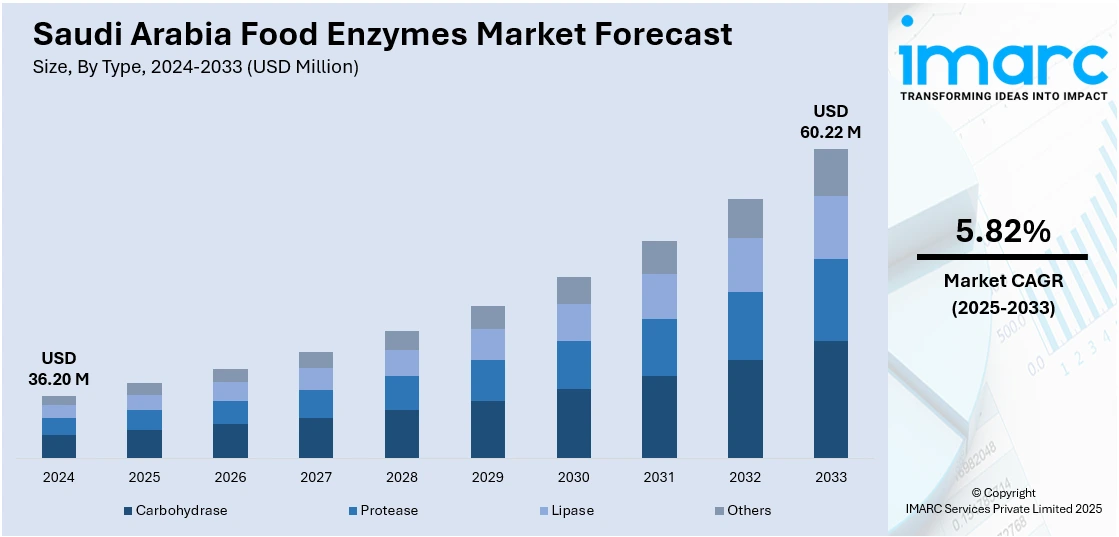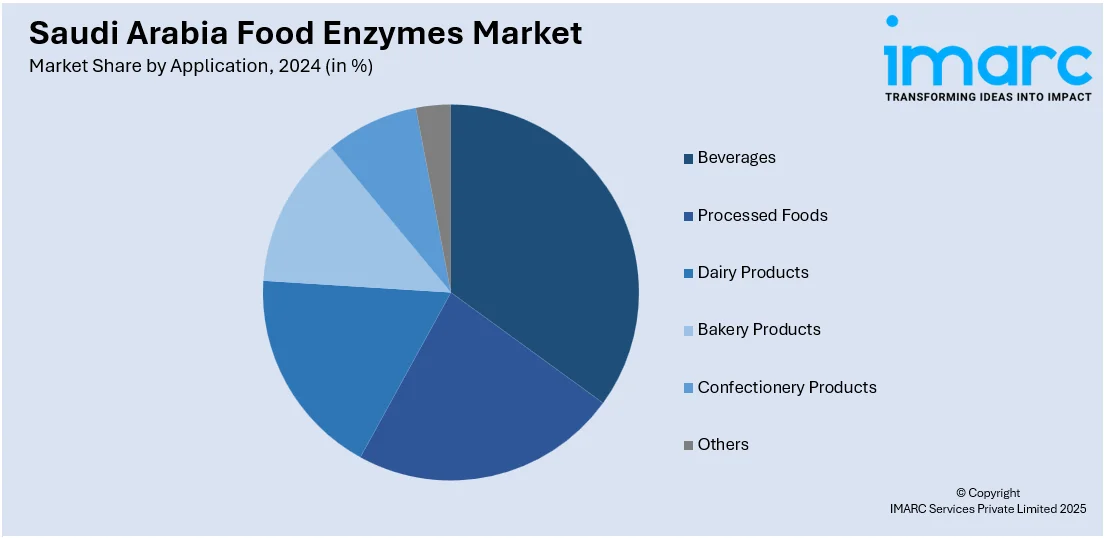
Saudi Arabia Food Enzymes Market Size, Share, Trends and Forecast by Type, Source, Formulation, Application, and Region, 2025-2033
Saudi Arabia Food Enzymes Market Overview:
The Saudi Arabia food enzymes market size reached USD 36.20 Million in 2024. Looking forward, IMARC Group expects the market to reach USD 60.22 Million by 2033, exhibiting a growth rate (CAGR) of 5.82% during 2025-2033. The market share is expanding, driven by the growing emphasis on food security and self-sufficiency in dairy production, along with the expansion of retail outlets, which aids in enhancing item accessibility and awareness.
|
Report Attribute
|
Key Statistics
|
|---|---|
|
Base Year
|
2024 |
|
Forecast Years
|
2025-2033
|
|
Historical Years
|
2019-2024
|
| Market Size in 2024 | USD 36.20 Million |
| Market Forecast in 2033 | USD 60.22 Million |
| Market Growth Rate 2025-2033 | 5.82% |
Saudi Arabia Food Enzymes Market Trends:
Rising preferences for high-quality dairy products
The growing preferences for high-quality dairy products are offering a favorable the market outlook. Individuals in the country are focusing on the nutritional value, texture, and digestibility of dairy products, such as cheese, yogurt, and milk. This change in consumer habits is leading manufacturers to employ advanced food enzyme technologies to improve product quality and extend shelf life. Enzymes like rennet and lactase are commonly utilized in the manufacturing process to enhance consistency, taste, and digestibility, particularly for those who are lactose intolerant. As the awareness about health and wellness is growing, people are looking for dairy options that are both nutritious and easy to digest, driving the demand for enzyme-treated items. Additionally, the increasing influence of Western dietary habits and an expanding expatriate population is also creating a wider market for high-quality dairy. The government’s emphasis on food security and self-sufficiency in dairy production is motivating local manufacturers to adopt enzyme technologies to meet rising standards. Consequently, the integration of food enzymes is becoming important in the growth and modernization of Saudi Arabia’s dairy industry. According to the IMARC Group, the Saudi Arabia dairy market is set to attain USD 8.4 Billion by 2033, exhibiting a growth rate (CAGR) of 3.8% during 2025-2033.

Expansion of retail outlets
The expansion of retail channels is fueling the Saudi Arabia food enzymes market growth. As per industry reports, in 2024, wholesale and retail commerce, along with restaurants and hotels, recorded the highest annual growth rate of 6.4%. As supermarkets, hypermarkets, and convenience stores continue to broaden across urban and semi-urban areas, they are offering a wide assortment of processed and packaged food products that rely on food enzymes for improved quality, texture, and shelf life. With modern retail formats, people are exposed to a broader selection of enzyme-based bakery and meat items, which increases their familiarity and preference for such items. The growing retail infrastructure also allows manufacturers to launch new enzyme-enhanced food products more efficiently and reach a larger customer base. Organized retail chains often feature cold storage and proper inventory systems that preserve the quality of enzyme-treated food items, encouraging frequent purchases. Promotions, product sampling, and health awareness campaigns run by retail outlets are further educating individuals on the benefits of food enzymes. As competition is rising within the retail sector, companies are focusing on offering value-added and high-quality products, driving the demand for specialized enzymes in food processing.
Saudi Arabia Food Enzymes Market Segmentation:
IMARC Group provides an analysis of the key trends in each segment of the market, along with forecasts at the country and regional level for 2025-2033. Our report has categorized the market based on type, source, formulation, and application.
Type Insights:
- Carbohydrase
- Amylase
- Cellulase
- Lactase
- Pectinase
- Others
- Protease
- Lipase
- Others
The report has provided a detailed breakup and analysis of the market based on the type. This includes carbohydrase (amylase, cellulase, lactase, pectinase, and others), protease, lipase, and others.
Source Insights:
- Microorganisms
- Plants
- Animals
A detailed breakup and analysis of the market based on the source have also been provided in the report. This includes microorganisms, plants, and animals.
Formulation Insights:
- Powder
- Liquid
- Others
The report has provided a detailed breakup and analysis of the market based on the formulation. This includes powder, liquid, and others.
Application Insights:

- Beverages
- Processed Foods
- Dairy Products
- Bakery Products
- Confectionery Products
- Others
A detailed breakup and analysis of the market based on the application have also been provided in the report. This includes beverages, processed foods, dairy products, bakery products, confectionery products, and others.
Regional Insights:
- Northern and Central Region
- Western Region
- Eastern Region
- Southern Region
The report has also provided a comprehensive analysis of all the major regional markets, which include Northern and Central Region, Western Region, Eastern Region, and Southern Region.
Competitive Landscape:
The market research report has also provided a comprehensive analysis of the competitive landscape. Competitive analysis such as market structure, key player positioning, top winning strategies, competitive dashboard, and company evaluation quadrant has been covered in the report. Also, detailed profiles of all major companies have been provided.
Saudi Arabia Food Enzymes Market News:
- In September 2024, a research team investigated the dissolution of coagulated blood from slaughtered cattle by alkaline protease generated by Streptomyces violaceoruber that was sourced from saline soil in Saudi Arabia. The group found out that alkaline protease was among the fibrinolytic enzymes and the preferred option for treating cardiovascular conditions and breaking down blood clots. S. violaceoruber was an effective producer of alkaline protease that easily dissolved blood clots.
- In March 2024, a research team from Saudi Arabia found a new technique for using waste cooking oil to produce biodiesel with an effective immobilized thermostable lipase, ensuring environmental and economic sustainability. This lipase demonstrated resistance to high temperatures and showed excellent activity and stability at alkaline pH levels. The enzyme was capable of being reused for two cycles, retaining 80% of its activity after the first reuse and 68% after the second.
Saudi Arabia Food Enzymes Market Report Coverage:
| Report Features | Details |
|---|---|
| Base Year of the Analysis | 2024 |
| Historical Period | 2019-2024 |
| Forecast Period | 2025-2033 |
| Units | Million USD |
| Scope of the Report | Exploration of Historical Trends and Market Outlook, Industry Catalysts and Challenges, Segment-Wise Historical and Future Market Assessment:
|
| Types Covered |
|
| Sources Covered | Microorganisms, Plants, Animals |
| Formulations Covered | Powder, Liquid, Others |
| Applications Covered | Beverages, Processed Foods, Dairy Products, Bakery Products, Confectionery Products, Others |
| Regions Covered | Northern and Central Region, Western Region, Eastern Region, Southern Region |
| Customization Scope | 10% Free Customization |
| Post-Sale Analyst Support | 10-12 Weeks |
| Delivery Format | PDF and Excel through Email (We can also provide the editable version of the report in PPT/Word format on special request) |
Key Questions Answered in This Report:
- How has the Saudi Arabia food enzymes market performed so far and how will it perform in the coming years?
- What is the breakup of the Saudi Arabia food enzymes market on the basis of type?
- What is the breakup of the Saudi Arabia food enzymes market on the basis of source?
- What is the breakup of the Saudi Arabia food enzymes market on the basis of formulation?
- What is the breakup of the Saudi Arabia food enzymes market on the basis of application?
- What is the breakup of the Saudi Arabia food enzymes market on the basis of region?
- What are the various stages in the value chain of the Saudi Arabia food enzymes market?
- What are the key driving factors and challenges in the Saudi Arabia food enzymes market?
- What is the structure of the Saudi Arabia food enzymes market and who are the key players?
- What is the degree of competition in the Saudi Arabia food enzymes market?
Key Benefits for Stakeholders:
- IMARC’s industry report offers a comprehensive quantitative analysis of various market segments, historical and current market trends, the Saudi Arabia food enzymes market forecast, and dynamics from 2019-2033.
- The research report provides the latest information on the market drivers, challenges, and opportunities in the Saudi Arabia food enzymes market.
- Porter's five forces analysis assist stakeholders in assessing the impact of new entrants, competitive rivalry, supplier power, buyer power, and the threat of substitution. It helps stakeholders to analyze the level of competition within the Saudi Arabia food enzymes industry and its attractiveness.
- Competitive landscape allows stakeholders to understand their competitive environment and provides an insight into the current positions of key players in the market.
Need more help?
- Speak to our experienced analysts for insights on the current market scenarios.
- Include additional segments and countries to customize the report as per your requirement.
- Gain an unparalleled competitive advantage in your domain by understanding how to utilize the report and positively impacting your operations and revenue.
- For further assistance, please connect with our analysts.
 Request Customization
Request Customization
 Speak to an Analyst
Speak to an Analyst
 Request Brochure
Request Brochure
 Inquire Before Buying
Inquire Before Buying




.webp)




.webp)












